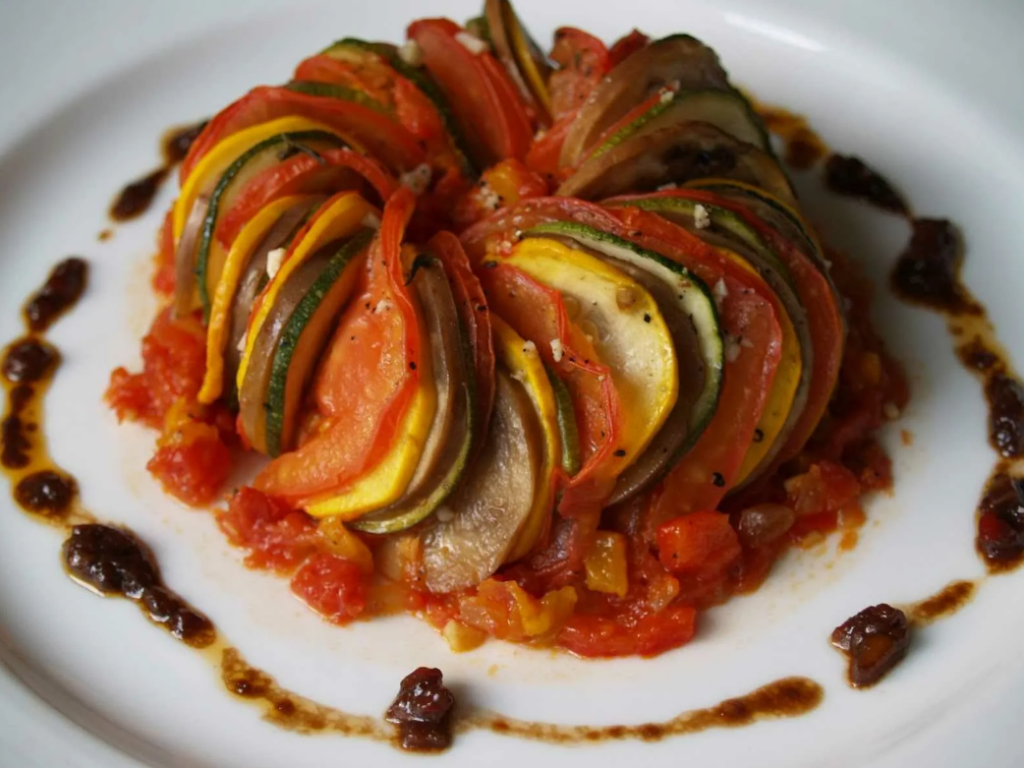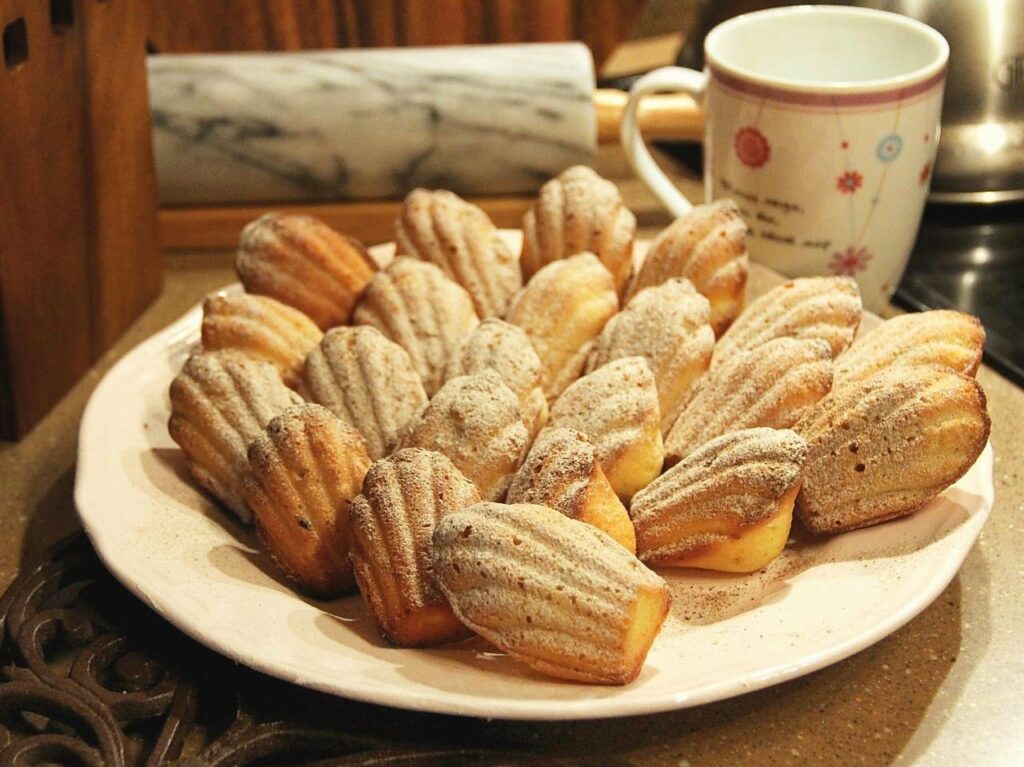Béchamel sauce, also known as white sauce, is a classic French sauce that serves as a versatile base for countless dishes in French cuisine and beyond. With its creamy texture and delicate flavor, Béchamel adds richness and depth to a wide range of savory dishes, from pasta to gratins to soufflés. Learning to master the art of making Béchamel sauce is a fundamental skill for any home cook or aspiring chef.
(more…)Category: Food
-
Ratatouille: Taste of history on your plate
Ratatouille is not just a dish, it is a true culinary legend that transports us into the world of aromas and flavors of the French countryside. It is an exquisite combination of vegetables, spices, and traditions that captivates the imagination and satisfies the most discerning palate.
The history of ratatouille dates back to the depths of France’s past. It is first mentioned in culinary literature of the 18th century, but its real popularity came later, thanks to the famous animated movie of the same name, which only heightened interest in this gastronomic delicacy.
The main ingredients of ratatouille are eggplants, zucchini, tomatoes, onions, peppers, and garlic. The vegetables are diced and simmered in olive oil with the addition of herbs and spices such as thyme, rosemary, and basil, which enrich the dish with their aroma.
Ratatouille is not only a delicious dish but also a real feast for the eyes. When served properly, the vegetables are arranged in a baking dish in the form of a colorful mosaic pattern, giving the dish additional refinement and aesthetic appeal.

While the original French recipe for ratatouille is simple and accessible, there are many variations of this dish in various culinary traditions. For example, in Mediterranean cuisine, it may be complemented with olives and capers, while in Italian cuisine, mozzarella and balsamic vinegar may be added.
Making ratatouille is a true creative process, where each step is filled with love for food and respect for traditions. This dish not only nourishes the body but also soothes the soul, reminding us of the wonderful moments of family dinners and gatherings with loved ones.
Thus, ratatouille is not just food; it is a true symbol of gastronomic and cultural heritage that can unite us around the table and bring joy and satisfaction to everyone who tries it.
-
The Art of Making Authentic French Onion Soup
In the culinary world, French onion soup holds a special place, captivating with its refined taste and aroma. This exquisite delicacy not only delights gourmets but also becomes a true art of preparation for those who strive to create something unique in the kitchen.
One of the key ingredients for this dish is, of course, onions. It is important to choose high-quality bulbs that will serve as the foundation for the rich and flavorful soup. The onions are finely sliced and sautéed over low heat to achieve a golden caramelization, adding sweetness and fragrance to the dish.
However, the magic of French onion soup is not limited to onions alone. Select herbs such as thyme and bay leaves impart sophistication and a distinctive flavor profile. The broth used for the soup can be vegetable or chicken, with prolonged simmering to extract all the juices and flavors of the ingredients.
An integral part of the recipe is the toasting of bread croutons with cheese, which are then placed on the surface of the soup and grilled. This touch not only adds texture to the dish but also imparts a unique taste, creating a harmonious blend of flavor nuances.
The finished French onion soup is a true sensory delight. Each spoonful combines warmth, tenderness, and aroma, revealing the richness of French culinary tradition to the gourmet. Making this dish is not just a culinary process; it is a genuine artistic endeavor that results in an incomparable culinary masterpiece.
-
How to Make the Perfect Croissant: Step-by-Step Recipe

Nothing quite matches the pleasure of a fresh, crispy croissant, which crumbles into thousands of delicate bread layers at the first touch. In this article, we present to you a step-by-step recipe for making this French delicacy at home, so you can enjoy the perfect croissant in the comfort of your own kitchen.
Ingredients:
- 2 cups all-purpose flour
- ¼ cup sugar
- 1 teaspoon salt
- 1 cup milk
- 1 cup butter
- 1 egg for brushing the croissants before baking
Step 1: Making the Dough
Combine the flour, sugar, and salt in a large bowl. Add the milk and mix until a uniform dough is formed. Set it in a warm place to rise for 1 hour.Step 2: Rolling Out the Butter Layers
Roll out the butter between two sheets of parchment paper into a rectangular shape. Place it in the refrigerator for 30 minutes.Step 3: Layering the Dough and Butter
Roll out the dough into a rectangle, place the layer of butter on the dough, then fold the dough over the butter. Repeat this process three times to create a layered texture.Step 4: Cutting and Shaping the Croissants
Roll out the dough to a thickness of 1 centimeter. Cut out triangles and roll them into croissant shapes. Leave them to rise for 30 minutes.Step 5: Baking
Brush the croissants with beaten egg and bake in the oven at 200 degrees Celsius for about 15-20 minutes, until they turn golden brown.Step 6: Enjoyment
Let the croissants cool slightly before indulging in their delicate crispy texture. Serve with jam, butter, or your favorite filling.With this recipe, you’ll be able to create the perfect croissant right in your own home and treat yourself and your loved ones to the incredible taste of French classic.
-
The Art of French Baking: Traditional Desserts That Evoke Childhood Memories
There’s something magical about the art of French baking that transcends generations and lingers in our memories. From the delicate aroma of freshly baked pastries to the intricate layers of flaky croissants, French desserts hold a special place in many of our childhood recollections. These time-honored treats not only tantalize our taste buds but also evoke a sense of nostalgia, reminding us of carefree moments spent savoring these delectable delights.
French baking is an intricate dance of precise techniques and quality ingredients, resulting in an array of mouthwatering creations that have stood the test of time. Among the numerous traditional desserts that are emblematic of childhood bliss, a few classics hold a particularly cherished spot.
One cannot speak of French baking without mentioning the iconic madeleine. This petite shell-shaped sponge cake, with its soft, buttery texture and hint of citrus, transports many back to afternoons spent indulging in its delicate flavors alongside a cup of warm tea. Its simplicity belies the intricate craftsmanship required to achieve that perfect golden hue and light, airy crumb.

For those with a penchant for flaky, buttery pastry, the memory of biting into a freshly baked pain au chocolat can elicit a wave of nostalgia. This quintessential French viennoiserie, with its rich, dark chocolate encased within layers of crisp, golden dough, has been a staple in French bakeries for generations. Its unmistakable aroma and indulgent taste have remained a beloved treat for both young and old.
And then, of course, there’s the alluring tarte Tatin, with its caramelized apples nestled beneath a buttery, golden crust. The sweet aroma of caramelized sugar and warm apples infuses the air, instantly conjuring memories of cozy family gatherings and the comforting warmth of home. This rustic yet elegant dessert embodies the heartwarming essence of French culinary traditions.
French baking, with its emphasis on precision, patience, and quality ingredients, not only produces delectable pastries but also serves as a conduit to cherished childhood memories. As we savor these timeless desserts, we are transported to simpler times, where the joy of a perfectly crafted treat could brighten even the cloudiest of days.
In every flake of pastry, in every bite of a delicate confection, the art of French baking preserves the essence of childhood, allowing us to relive moments of sweetness and simplicity, one delectable bite at a time.